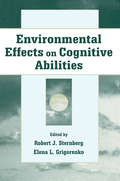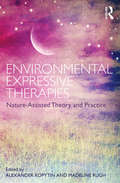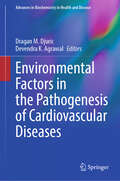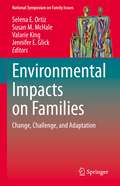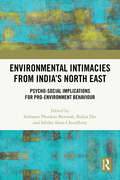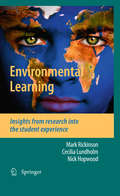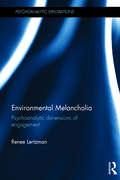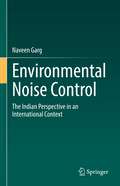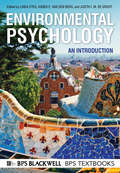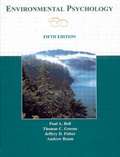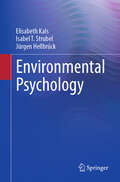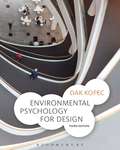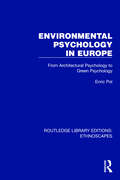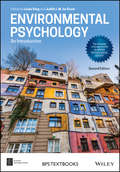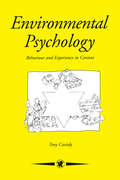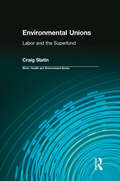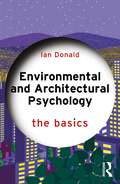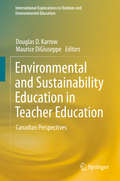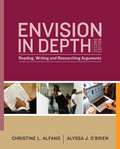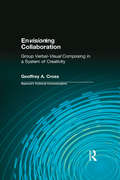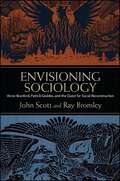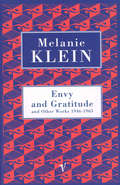- Table View
- List View
Environmental Effects on Cognitive Abilities
by Robert J. Sternberg Elena L. GrigorenkoIt sometimes seems that it is difficult to pick up a current newspaper or a magazine without it containing a story about some behavioral characteristic for which it has been found that a gene is responsible. Even aspects of behavior that one would feel certain are environmentally controlled are now being attributed in part to the effects of the genes. But genes never act alone: Their effects are always filtered through the environment. The goal of this volume is to discuss how the environment influences the development and the maintenance of cognitive abilities. It is a successor to the editors' 1997 volume, Intelligence, Heredity, and Environment, and a companion to their new volume, Family Environment and Intellectual Functioning: A Life-Span Perspective. Taken together, the two-volume set comprises the most comprehensive existing work on the relation between the environment and cognitive abilities. Psychologists, parents, social workers, educators, and employers are all likely to find this book of interest.
Environmental Expressive Therapies: Nature-Assisted Theory and Practice
by Madeline Rugh Alexander KopytinEnvironmental Expressive Therapies contributes to the emerging phenomenon of eco-arts therapy by highlighting the work that international expressive arts therapists have accomplished to establish a framework for incorporating nature as a partner in creative/expressive arts therapy practices. Each of the contributors explores a particular specialization and outlines the implementation of multi-professional and multi-modal "earth-based" creative/expressive interventions that practitioners can use in their daily work with patients with various clinical needs. Different forms of creative/expressive practices—such as creative writing, play therapy techniques, visual arts, expressive music, dramatic performances, and their combinations with wilderness and animal-assisted therapy—are included in order to maximize the spectrum of treatment options. Environmental Expressive Therapies represents a variety of practical approaches and tools for therapists to use to achieve multiple treatment goals and promote sustainable lifestyles for individuals, families, and communities.
Environmental Factors in the Pathogenesis of Cardiovascular Diseases (Advances in Biochemistry in Health and Disease #30)
by Devendra K. Agrawal Dragan M. DjuricEnvironmental conditions and processes are one of the major pillars on which the human well-being rests. It is the core responsibility of the society to preserve and enhance better conditions for the human well-being. Indeed, there are several evolving unmet needs in public health. Emerging and re-emerging infectious diseases and a surge in the incidence of non-communicable diseases, including cardiovascular diseases (CAD), chronic respiratory diseases, and metabolic diseases have been impediments to sustainable well-being. Many factors are critical in the global surge in the rate and incidence of cardiovascular diseases. These include the shift from acute to chronic conditions, the shift from single risk factor vs. multiple influences, aging population, global health disparities, exposure to lower harmful influences over a longer period, etc. However, the epigenetic factors due to unhealthy environment play a most significant role in the underlying pathogenesis of cardiovascular diseases. Unfortunately, this has been ignored for a long time and realized lately to expand and disseminate knowledge to general population, expand research activities to investigate the cellular and molecular mechanisms, and develop better preventive and treatment strategies. The most significant environmental impoverishment in the pathogenesis of cardiovascular diseases include different genetical, chemical, physical, and biological influences, but not limited to, socio-economic status and lack of nutrients, nutritional aspects including habits, diets and additives, inhaled and ingested pollutants, exhaust gas and gasoline products, tobacco smoke, water pollution, alcohol consumption, soil and mineral pollution, solvents, pesticides, microplastics, non-critical usage of drugs, climate change, extreme atmospheric conditions, extremes in noise and temperature, electromagnetic influences, microwaves and radiation, outdoor light pollution, mental stressors, lack of or over exercise, microbiota and microbiological agents like SARS CoV-2 virus, etc.
Environmental Impacts on Families: Change, Challenge, and Adaptation (National Symposium on Family Issues #12)
by Valarie King Susan M. McHale Jennifer E. Glick Selena E. OrtizThis book examines ways in which families’ physical environments have implications for their relationships and the health and well-being of their members. Attention is given to three aspects of the physical environment—disasters, climate change, and the built environment—and the challenges these may create for families. Chapters describe particular considerations within each of these three physical environment challenges, the ways they affect families, and factors that protect families, promote their resilience and enable them to flourish. Finally, the volume offers recommendations for the role of government programs and policies to support families to overcome and/or adapt to environmental challenges as well as highlights the efficacy of evidence-based interventions aimed at promoting family resilience.Featured areas of coverage include: Extreme natural events and families’ postdisaster recovery.Family adaptations to climate change.The built environment and children’s health and well-being.Community-driven approaches to address environmental inequities.The urban environment of family caregiving. Environmental Impacts on Families is a must-have resource for researchers, professors, and graduate students as well as clinicians, therapists, policymakers, and other related professionals in developmental psychology, family studies, environmental health and policy, social work, public health, educational policy and politics, economics, migration studies, and all interrelated disciplines.
Environmental Intimacies from India’s North East: Psycho-Social Implications for Pro-Environment Behaviour
by Indranee Phookan Borooah Sabiha Alam Choudhury Bidita DasThis book explores the intimate relationship of the people of North East India with the environment as evinced from their traditional beliefs, cultural practices, and livelihood. It offers insights into the challenges and adaptability of communities through actions ensuring conservation of the environment yet sustaining their livelihood.The book encompasses movement toward responsible actions and the engagement of communities in pro-environmental behavior. It showcases the various practices, knowledge, and debates on the environment-behavior relationship of the people of North East India. It brings into focus some of the daunting environmental issues and the endeavors for sustenance that is true to a region which is rich in ecological diversity and touches the spirit and psyche of its people.This volume will be of interest to scholars and researchers of psychology, anthropology, sociology, environmental sciences, development studies, law and governance, environmental administration, and South Asia studies.
Environmental Learning: Insights from research into the student experience
by Cecilia Lundholm Mark Rickinson Nick HopwoodEnvironmental education and education for sustainable development have become features of many countries' formal education systems. To date, however, there have been few attempts to explore what such learning looks and feels like from the perspective of the learners. Based on in-depth empirical studies in school and university classrooms, this book presents rich insights into the complexities and dynamics of students' environmental learning. The authors show how careful analysis of students' environmental learning experiences can provide powerful pointers for future practice, policy and research. Environmental Learning will be a key resource for educators, teacher educators, decision-makers and researchers involved in education and sustainable development.
Environmental Melancholia: Psychoanalytic dimensions of engagement (Psychoanalytic Explorations)
by Renee LertzmanIn this groundbreaking book, Renee Lertzman applies psychoanalytic theory and psychosocial research to the issue of public engagement and public apathy in response to chronic ecological threats. By highlighting unconscious and affective dimensions of contemporary ecological issues, Lertzman deconstructs the idea that there is a gap between what people care about and what is actually carried out in policy and personal practice. In doing so, she presents an innovative way to think about and design engagement practices and policy interventions. Based on key qualitative fieldwork and in-depth interviews conducted in Green Bay, Wisconsin, each chapter provides a psychosocial, psychoanalytic perspective on subjectivity, affect and identity, and considers what this means for understanding behaviour in relation to environmental crises and climate change. The book argues for a theory of environmental melancholia that accounts for the ways in which people experience profound loss and disruption caused by environmental issues, and yet may have trouble expressing or making sense of such experiences. Environmental Melancholia offers a fresh perspective to the field of environmental psychology that until now has been largely dominated by research in cognitive, behavioural and social psychology. It will appeal to academics, researchers and postgraduate students in the fields of psychoanalysis, psychosocial studies and sustainability, as well as policy makers and educators internationally.
Environmental Noise Control: The Indian Perspective in an International Context
by Naveen GargThis book provides a concise and up-to-date overview of environmental noise control issues, utilizing specific case studies from India to help explore noise mapping and monitoring, impact analysis, and policy, among other relevant topics. The book provides an extensive review of recent studies, including references, and describes the latest noise monitoring structures. It also addresses heretofore under-emphasized topics, including but not limited to acoustic metrology, Multi Attribute Decision Making (MADM) techniques, and sound insulation utilizing passive control strategies.
Environmental Pollution and the Brain
by Sultan Ayoub MeoEnvironmental pollution is an emerging global public health problem of both developing and developed nations. Such pollution is a major risk factor for many illnesses, including nervous system disorders. This book combines the highlights the effects of environmental pollution on brain biology. It will be a thorough overview of the pathophysiological and oxidative stress mechanisms and how environmental pollution affects the brain biology. The author discusses environmental pollution and brain development, memory, autism, hearing and vision loss and brain cancer. Several chapters address controversial topics such as the effect of Electromagnetic Field Radiation (RF-EMFR).
Environmental Psychology
by Linda Steg Agnes E. van den Berg Judith I. de GrootEnvironmental Psychology: An Introduction offers a research-based introduction to the psychological relationship between humans and their built and natural environments and discusses how sustainable environments can be created to the benefit of both people and natureExplores the environment's effects on human wellbeing and behaviour, factors influencing environmental behaviour and ways of encouraging pro-environmental actionProvides a state-of-the-art overview of recent developments in environmental psychology, with an emphasis on sustainability as a unifying principle for theory, research and interventionsWhile focusing primarily on Europe and North America, also discusses environmental psychology in non-Western and developing countriesResponds to a growing interest in the contribution of environmental psychologists to understanding and solving environmental problems and promoting the effects of environmental conditions on health and wellbeing
Environmental Psychology
by Andrew S. Baum Paul A. Bell Thomas C Greene Jeffrey D. FisherBell et al’s Environmental Psychology is considered to be the most authoritative textbook available for this course. It is the only environmental psychology book to appear in five editions. It is noted for its focus on the application of science and theory to the solution of problems involving natural and altered environments. The book reviews the application of practical solutions to everyday environmental problems. The authors integrate theory, research, and application using their unifying, eclectic model to demonstrate human-environment interaction. The book reviews how we are a product of our environment, our biology, and the interaction of the two. It discusses how our physical environment such as noise and weather impact us. It also reviews how we can modify our environment through design principles such as aesthetics, and how we modify our environment when we disregard the impact other people and/or elements have on our ecological system. Each chapter addresses both micro and macro- environmental influences, including the short- and long-term effects of both. <P><P>The opening chapter provides a historical context and introduces the reader to the research methods central to the discipline. The next 4 chapters introduce environmental attitudes, values, and ethics and the principles that apply to environmental assessment; models of perception & cognition, including how we process and store environmental information; and the major theories of human-environment interaction. The next 6 chapters explore a variety of environmental influences such as noise, climate, natural disasters (including the effects of pollution), crowding, and city life, and how they impact us. The next 2 chapters examine how environmental psychology principles can be applied to residences, institutional settings (i.e.schools) and work and leisure environments. The book concludes with a chapter on how we can change behavior that harms the environment. The book is intended as a text for courses on environmental psychology, environment and behavior, social ecology, architectural psychology, ecological psychology or environmental design or studies, taught in departments of psychology, sociology, environmental science, and biology.
Environmental Psychology
by Elisabeth Kals Jürgen Hellbrück Isabel T. StrubelEnvironmental Psychology deals with human-environment interactions as relationships between the physical-material and sociocultural outer world, as well as human experience and behavior. This fully revised second edition provides a well-structured, clearly understandable overview of the topics and developments of this increasingly significant sub-discipline of psychology and makes it clear that environmental psychology is a highly relevant field of research and application in the present and future.
Environmental Psychology for Design
by Dak KopecHow does a room affect an occupant's behavior and well-being? How does a building influence its residents' health? Environmental Psychology for Design, 3rd Edition, explores these questions with an in-depth look at psychosocial responses to the built environment. Awarded the 2006 ASID Joel Polsky Prize, the first edition served as an introduction to the discipline of environmental psychology and inspired readers to embrace its key concepts and incorporate them into their practice. This 3rd edition continues to analyze the interaction between environments and human behavior and well-being, while exploring how individual differences related to age, gender, and cultural background impact that interaction.
Environmental Psychology in Europe: From Architectural Psychology to Green Psychology (Routledge Library Editions: Ethnoscapes)
by Enric PolOriginally published in 1993, as part of the Ethnoscapes: Current Challenges in the Environmental Social Sciences series, reissued now with a new series introduction and new preface, Environmental Psychology in Europe: From Architectural Psychology to Green Psychology sets out to explain the nature of environmental psychology, how it was born, how it developed, what were its dominant subjects, its principal actors and its present state in Europe at the time. The volume covers each European country, looking at the origin and development of the subject in the principal European cultural areas.
Environmental Psychology: An Introduction (BPS Textbooks in Psychology)
by Judith I. de GrootThe updated edition of the essential guide to environmental psychology Thoroughly revised and updated, the second edition, Environmental Psychology: An Introduction offers an overview of the interplay between humans and their environments. The text examines the influence of the environment on human experiences, behaviour and well-being and explores the factors influencing environmental behaviour, and ways to encourage pro-environmental behaviour. The revised edition is a state-of-the art review of relevant theories and research on each of these topics. With contributions from an international panel of noted experts, the text addresses a wealth of topics including the main research methods in environmental psychology; effects of environmental stress; emotional impacts and meanings of natural environment experience; aesthetic appraisals of architecture; how to measure environmental behaviour; cognitive, emotional and social factors explaining environmental behaviour; effects and acceptability of strategies to promote pro-environmental factors; and much more. This important book: Discusses the environmental factors that threaten and promote human wellbeing Explores a wide range of factors influencing actions that affect environmental conditions Discusses the effects and acceptability of approaches that aim to encourage pro-environmental behavior Presents research results conducted in different regions in the world Contains contributions from noted experts Written for scholars and practitioners in the field, the revised edition of Environmental Psychology offers a comprehensive review of the most recent research available in environmental psychology.
Environmental Psychology: Behaviour and Experience In Context (Contemporary Psychology Ser.)
by Tony CassidyThis text contains an up-to-date survey of theory, research and practice in environmental psychology, drawing on international literature. It adopts the perspective that physical and social factors are inextricably linked in their influence on human behaviour and experience and that the world in which we live is changed and often damaged by human action.; Throughout the text, the issues which are important in contemporary psychology, such as levels of explanation, methodological diversity and the relationship between psychology and other disciplines, are brought to the fore. The text covers established areas of environmental concern and also brings together research on rarely covered topics, such as the effects of smell, colour and light, and the way in which physical environments influence social identity.
Environmental Unions: Labor and the Superfund (Work, Health and Environment Series)
by Craig SlatinDuring the 1970s and 1980s, a hazardous waste management industry emerged in the U.S., driven by government and polluting industry responses to a hazardous waste crisis. In 1979, labor unions began to seek federal health and safety protections for workers in that industry and for firefighters responding to hazardous materials fires. Those efforts led to a worker health and safety section in the Superfund Amendments and Reauthorization Act of 1986. The legislation mandated regulation of hazardous waste operations and emergency response worker protection, and establishment of a national health and safety training grant program - which became the Worker Education and Training Program (WETP).Craig Slatin provides a history of labor's success on the coattails of the environmental movement and in the middle of a rightward shift in American politics. He explores how the WETP established a national worker training effort across industrial sectors, with case studies on the health and safety training programs of two unions in the WETP - the Oil, Chemical, and Atomic Workers and the Laborers' Union. Lessons can be learned from one of the last major worker health and safety/environmental protection victories of the 1960s-1980s reform era, coming at the end of the golden age of regulation and just before the new era of deregulation and market dominance. Slatin's analysis calls for a critical survey of the social and political tasks facing those concerned about worker and community health and environmental protection in order to make a transition toward just and sustainable production.
Environmental and Architectural Psychology: The Basics (The Basics)
by Ian DonaldEnvironmental and Architectural Psychology: The Basics is a jargon-free and accessible introduction to the relationship between people and their natural and built environment. Exploring everything from the effectiveness of open plan offices to how people respond to life-threatening disasters, the book addresses issues around sustainability, climate change, and behaviour, and is grounded in theory and ideas drawn from psychology, geography, and architecture. Author Ian Donald introduces both the theoretical underpinnings and the applications of environment-behaviour research to solving real world problems, encouraging readers to reflect on the role of design and policy in shaping the environments in which they live and work. With chapters considering the impact of environment on identity, wellbeing, crime, and spatial behaviour, Donald shows us not only how people shape and affect the environment, but also in turn how the environment shapes and affects people’s thoughts, feelings, and behaviours. Addressing some of the most important questions of our time, including how behaviour drives climate change, and what we can do about it, this is the ideal book for anyone interested in the interactions between architecture, the environment, and psychology.
Environmental and Sustainability Education in Teacher Education: Canadian Perspectives (International Explorations in Outdoor and Environmental Education)
by Douglas D. Karrow Maurice DiGiuseppeThis book was inspired by the inaugural National Roundtable on Environmental and Sustainability Education in Canadian Faculties of Education (Roundtable 2016), which took place June 14-16, 2016, at Trent University in Peterborough, Ontario. Roundtable 2016 brought together over seventy participants from across Canada, including educators, researchers, policy-makers, consultants, and community organizations. Over the course of three days, participants took part in keynote addresses, research colloquia, networking socials, and collaborative inquiry activities focused on Environmental Sustainability Education in Teacher Education (ESE-TE). Roundtable 2016 resulted in the publication of a National Action Plan containing action-oriented recommendations for enhancing ESE-TE, and a position statement titled “The Otonabee Declaration,” where delegates articulated their views regarding environmental degradation, the critical need for enhancing ESE-TE, and, the role educators, children, youth, educational institutions, policy makers, and Indigenous communities play in enhancing ESE-TE in Canada. This volume concludes with a discussion placing current Canadian ESE-TE theory and practice within an international context.
Envision In Depth: Reading, Writing, and Researching Arguments
by Christine Alfano Alyssa O'BrienEnvision in Depth: Reading, Writing, and Researching Arguments 2/e, is a combined rhetoric and reader intended for composition courses focusing on argumentation and research-based writing. Taking contemporary culture as its central theme and context, Envision in Depth is concerned with the fundamentals of analyzing and writing powerful, effective arguments. Students using Envision in Depth will learn how to analyze and compose arguments, design and conduct research projects, and produce persuasive visual and oral presentations in response to over 100 contemporary arguments in a wide range of verbal and visual genres.
Envisioning Collaboration: Group Verbal-visual Composing in a System of Creativity (Baywood's Technical Communications)
by Geoffrey A. Cross Charles H. SidesThe dissemination of desktop publishing and web authoring software has allowed nearly everyone in industrialized countries to combine verbal and visual symbols into text. Serious multimodal projects often demand extensive teamwork, especially in the workplace. But how can collaboration engaging such different traditions of expression be conducted effectively? To address this question, Envisioning Collaboration traces the composing processes of expert graphic artists and writers preparing advertising campaigns to retain a vital national account. It examines the influences on individual and dyadic composing processes of what Csikszentmihalyi terms "the domain," in this case the disciplinary knowledge of advertising, and "the field," in this case the surrounding economic conditions and client, vendor, customer, and agency executive gatekeepers. Based on a 460-hour participant-observation and intensive computerized data analysis, Envisioning Collaboration is the first book to meticulously examine collaborative creative processes at an award-winning advertising agency, including audience analysis, branding, collaborative "moves," power and conflict management, uses of humor, degree of mindfulness, and effectiveness. The findings indicate the role of concepts in generating common texts by artists and writers, the role of the visual in individuals' composing, verbal-visual rhetorical elements in processes and products, and which verbal-visual techniques were most generative. Findings are related to pertinent research in technical and business writing, rhetoric and composition, and some key research in visual design, communication, advertising, neurolinguistics, management, and psychology. The book concludes with a pedagogical/training unit incorporating "gateway activities" for effective verbal-visual composition and collaboration.
Envisioning Sociology: Victor Branford, Patrick Geddes, and the Quest for Social Reconstruction (SUNY Press Open Access)
by John Scott Ray BromleyEnvisioning Sociology is a landmark work, the first major study of the founding of sociology in Britain and the enormous contributions made by the intellectual circle led by Victor Branford and Patrick Geddes. Authors John Scott and Ray Bromley chronicle the biographical connections and personal partnerships of the circle's key participants, their international connections, their organization-building work, and the business activities that underpinned their efforts. Branford and Geddes fashioned an ambitious and wide-ranging interdisciplinary vision, drawing on geography, anthropology, economics, and urban planning, in addition to sociology. This vision was an integral part of a project of social reconstruction, a "third way" eschewing both liberalism and communism in favor of cooperation, redistribution, and federalism. Envisioning Sociology uncovers a previously hidden history of the social sciences, giving readers a fascinating glimpse into early twentieth-century social science and political economy, while demonstrating the contemporary relevance of the ideas of these underrated figures. Although Branford and Geddes failed to establish the grand sociology they envisioned, their ideas helped develop the theory and practice of community development, participatory democracy, bioregionalism, historic preservation, and neighborhood upgrading.SUNY Press has collaborated with Knowledge Unlatched to unlock KU Select titles. The Knowledge Unlatched titles have been made open access through libraries coming together to crowd fund the publication cost. Each monograph has been released as open access making the eBook freely available to readers worldwide. Discover more about the Knowledge Unlatched program here: https://www.knowledgeunlatched.org/, and access the book online at the SUNY Open Access Repository at <a href="http://hdl.handle.net/20.500.12648/8479 ">http://hdl.handle.net/20.500.12648/8479 .
Envisioning the Dream Through Art and Science: With 100 Digitally Imaged Dreams (Imagery and Human Development Series)
by Robert G. Kuzendorf James VeatchThis monograph is the product of an interdisciplinary experiment--an artistic experiment and a psychological experiment--focused on dreams. Inspired by the prevalence of dream imagery and "dream logic" in surrealist art, the authors asked 100 art students to create digital images representing critical scenes from one of their dreams, then to create a surrealist collage from the digital images. The resulting collages tend to capture the surreality envisioned in actual works of surrealist art, as two collages included in the book illustrate. Inspired also by the psychological problem of studying other minds, the authors asked the 100 art students to describe their dream in writing, to interpret their dream, and to complete two personality measures: the Short Form of the Boundary Questionnaire and the Brief Symptom Inventory. The art students' scores on particular personality scales were found to be statistically associated with particular dream aspects, many of which are visually observable in the digitized dream images created by art students with particular personalities but are not verbally discernible in the dream descriptions written by those same students. The appendix contains, for each art student, the digitally imaged dream, the written description and written interpretation of the dream, and scores on the Boundary Questionnaire and on the depression, anxiety, hostility, and somatization scales of the Brief Symptom Inventory. The book concludes with a bibliography and an index to some of the visual elements in the 100 digitized dream images.
Envy And Gratitude And Other Works 1946-1963: A Study Of Unconscious Sources
by Melanie KleinA perfect introduction to Melanie Klein’s modern neuroscientific research. Melanie Klein's writings, particularly on infant development and psychosis, have been crucial both to theoretical work and to clinical practice. Envy and Gratitude collects her writings from 1946 until her death in 1960, including two papers published posthumously. Klein's major paper, 'Notes on Some Schizoid Mechanisms', introduces the concept of the paranoid-schizoid position, in which the infant ego splits, projects and introjects its objects - most particularly the mother - during the first few months of life. Envy and Gratitude, her last major work, introduces her theory of primary envy.
Envy Up, Scorn Down: How Status Divides Us
by Susan T. FiskeAn insightful examination of why we compare ourselves to those above and below us. The United States was founded on the principle of equal opportunity for all, and this ethos continues to inform the nation’s collective identity. In reality, however, absolute equality is elusive. The gap between rich and poor has widened in recent decades, and the United States has the highest level of economic inequality of any developed country. Social class and other differences in status reverberate throughout American life, and prejudice based on another’s perceived status persists among individuals and groups. In Envy Up, Scorn Down, noted social psychologist Susan Fiske examines the psychological underpinnings of interpersonal and intergroup comparisons, exploring why we compare ourselves to those both above and below us and analyzing the social consequences of such comparisons in day-to-day life. What motivates individuals, groups, and cultures to envy the status of some and scorn the status of others? Who experiences envy and scorn most? Envy Up, Scorn Down marshals a wealth of recent psychological studies as well as findings based on years of Fiske’s own research to address such questions. She shows that both envy and scorn have distinctive biological, emotional, cognitive, and behavioral characteristics. And though we are all “wired” for comparison, some individuals are more vulnerable to these motives than others. Dominant personalities, for example, express envy toward high-status groups such as the wealthy and well-educated, and insecurity can lead others to scorn those perceived to have lower status, such as women, minorities, or the disabled. Fiske shows that one’s race or ethnicity, gender, and education all correlate with perceived status. Regardless of whether one is accorded higher or lower status, however, all groups rank their members, and all societies rank the various groups within them. We rate each group as either friend or foe, able or unable, and accordingly assign them the traits of warmth or competence. The majority of groups in the United States are ranked either warm or competent but not both, with extreme exceptions: the homeless or the very poor are considered neither warm nor competent. Societies across the globe view older people as warm but incompetent. Conversely, the very rich are generally considered cold but highly competent. Envy Up, Scorn Down explores the nuances of status hierarchies and their consequences and shows that such prejudice in its most virulent form dehumanizes and can lead to devastating outcomes—from the scornful neglect of the homeless to the envious anger historically directed at Tutsis in Rwanda or Jews in Europe. Individuals, groups, and even cultures will always make comparisons between and among themselves. Envy Up, Scorn Down is an accessible and insightful examination of drives we all share and the prejudice that can accompany comparison. The book deftly shows that understanding envy and scorn—and seeking to mitigate their effects—can prove invaluable to our lives, our relationships, and our society.
